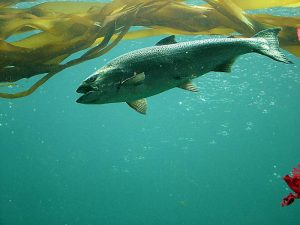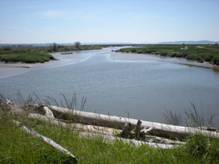
By Christopher Dunagan, Puget Sound Institute
A desire to come up with “bold actions” for rebuilding Chinook salmon runs in Puget Sound has slowed approval of the first Chinook Implementation Strategy designed to accelerate recovery efforts for the threatened species.
The Puget Sound Salmon Recovery Council, which oversees salmon-related planning, was scheduled to adopt the Chinook Implementation Strategy at its March meeting. The strategy underwent 14 months of study, discussion and review, and council staffers said it was ready for approval.
Before the meeting, however, representatives of Puget-Sound-area Indian tribes disagreed with that assessment, saying the proposed strategy was not specific enough about actions needed to save salmon. The document, they said, failed to provide enough direction to agencies and nonprofit groups working on salmon-restoration projects.
Tribal officials then offered to enlist tribal staffers in a relatively quick month-long project to identify some “bold actions” that could make a difference in salmon recovery.
“We are very excited that the tribes have offered to do this,” said Laura Blackmore, deputy director for the Puget Sound Partnership and facilitator of the Salmon Recovery Council.
One problem, she said, is that any delays by the Salmon Recovery Council could trigger a cascading effect of other delays. Putting off a decision on the Implementation Strategy until the council’s next meeting in May could mean that the bold ideas won’t be included in the next Action Agenda in 2018, she said. And leaving the ideas out of the next Action Agenda — the overall blueprint for Puget Sound recovery — could lead to a two-year delay in putting those ideas into action.
Blackmore and other staffers with the Puget Sound Partnership suggested that the tribes complete their recommendations within a month. To avoid a delay, council members could then go online and vote to approve or reject the tribal offerings. Ideas rejected by the council could be submitted as recommendations from the Tribal Management Conference, which represents the tribes.
During last week’s Salmon Recovery Council meeting, Alan Chapman, Endangered Species Act coordinator for the Lummi Nation, raised questions about the entire process. The Chinook Implementation Strategy was largely derived from the Chinook Recovery Plan, a wide-ranging plan developed to comply with the Endangered Species Act. Chinook are listed as “threatened” under the federal law.

Rather than a bold new strategy, the Implementation Strategy came out with general suggestions, he said. “There were no specifics that would work to move the dial (on salmon recovery)…. I would like people to say within the draft that we are going to do this and this and this. We need to get our head around what we want to see done over the next four years.”
As described in the Chinook Implementation Strategy, much has been learned about the needs of Chinook salmon since the federal recovery plan was adopted in 2005. Nevertheless, overall numbers of Chinook are not increasing, and many runs continue to decline.
Recommendations in the draft Implementation Strategy include protecting and restoring salmon habitat, improving communication about salmon harvest and hatcheries, and sharing technical information about successful restoration projects.
Scott Brewer, executive director of the Hood Canal Coordinating Council, commended those who had worked on the strategy, but he argued that suggestions from the tribes should be incorporated into the plan and not added as an afterthought.
“It is critical, I think, that we have tribal input,” Brewer said, adding that tribal officials should submit their recommendations and that those ideas should be discussed at the May meeting. The resulting plan could be amended and approved by the entire council.
Brewer said he recognizes the ramifications of a delay, but the issue is too important to be rushed through at the last moment, given the level of cooperation developed between tribal and non-tribal parties.
“My fear,” he said, “is that this pits the tribes against the council. I would suggest that we think of some innovative ways to make this work.”
Steve Hinton, representing the Swinomish Tribe, said he recognizes that a lot of work has gone into developing the strategy, including synthesizing information from various sources. But the document presented to the council lacks a sense of urgency, he said.
The term “bold actions” may sound cryptic, Hinton said, “but there are some solid thoughts about what we can do. We didn’t feel comfortable kicking the can down the road one more time. We need to do something that hits a home run.”
After the meeting, Hinton said ideas are still being discussed among the tribes, but one suggestion is to align policies, actions and restoration projects along watershed boundaries — regardless of how many counties, cities and tribes have jurisdiction in the drainage. The “bold ideas” are not necessarily new, he added, but they may diverge from the old way of doing things.
David Troutt, chairman of the Salmon Recovery Council and a representative of the Nisqually Tribe, said he would like the council to speak with one voice. He would also like to see the Chinook Implementation Strategy — including tribal recommendations — to be included in the next Action Agenda.
Blackmore said she would take the council’s wishes to those developing the 2018 Action Agenda, which is being written to influence funding for salmon-recovery projects over four years. The change from a two-year plan is awaiting approval from the Legislature.
After the meeting, Blackmore said she hopes to learn next week how the council’s delay on the Implementation Strategy could affect the next Action Agenda.
Christopher Dunagan is a senior writer at the Puget Sound Institute.